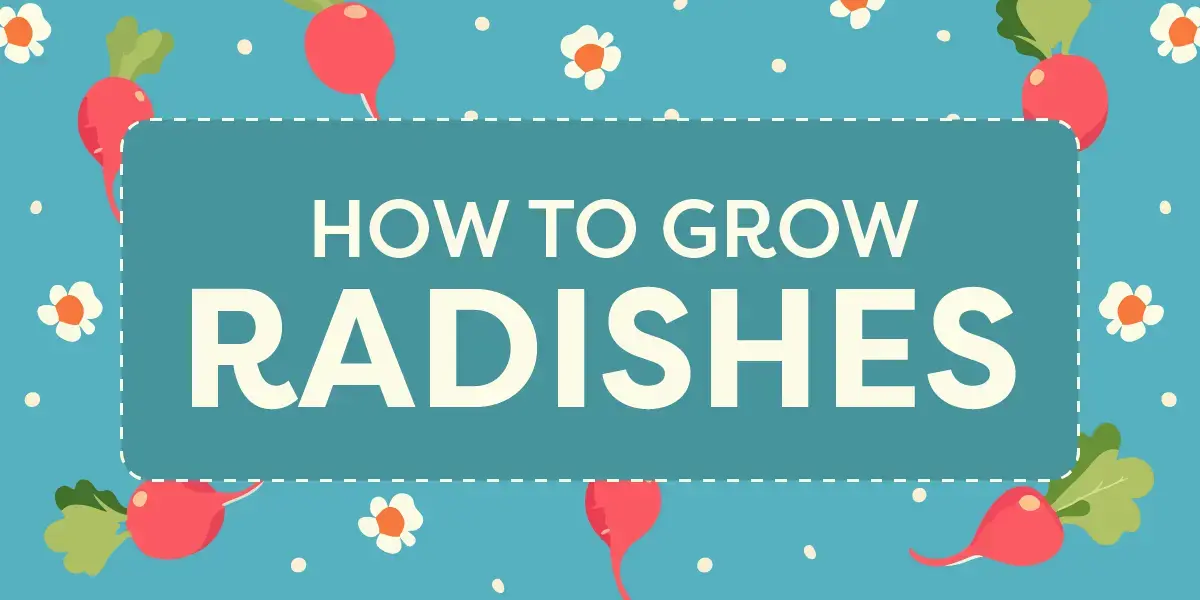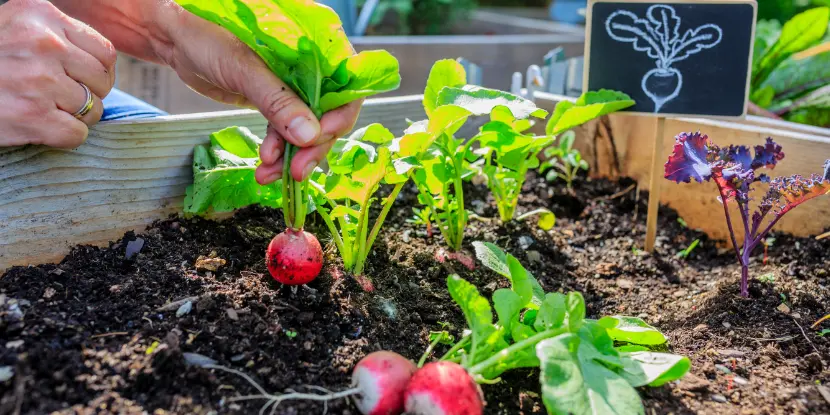Radishes are one of the fastest-growing vegetables and easiest to grow at home.
They’re so easy, in fact, that even the world’s worst gardener can cultivate them. We’re not implying anything here, but imagine what you can accomplish armed with the tips and tricks in this blog!
Home-grown radishes have more kick, which makes them stand out in salads and slaws, tacos, relishes, and even sandwiches. That’s because they’re harvested at peak freshness and consumed almost immediately before their sharpness fades on the shelf.
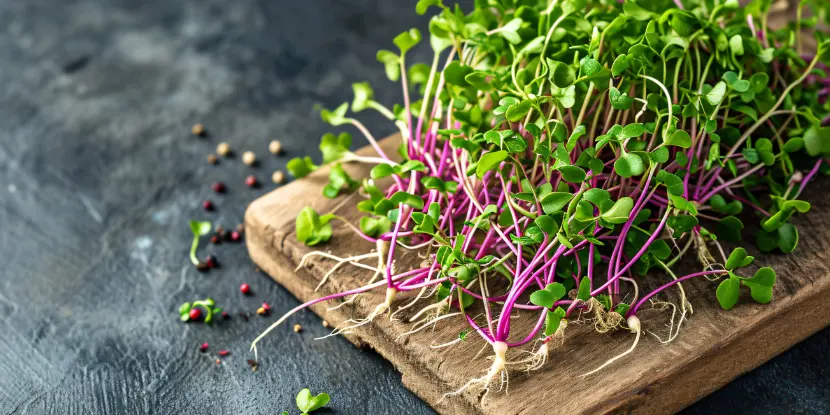
Radish sprouts make excellent micro-greens for salads and sandwiches.
Best Radishes to Grow in Southern California
- French Breakfast: A classic radish with a mild, slightly sweet flavor. Its elongated shape and bright red top fade into a white bottom.
- Cherry Belle: This variety grows exceptionally well in Southern California and offers a crisp, clean taste ideal for salads.
- Watermelon Radish: Visually striking, with an interior that resembles watermelon, these radishes have a slightly sweet and peppery flavor. They thrive in mild Southern California temperatures.
- Daikon: Daikon radishes are more heat tolerant than most varieties. They’re large and white, with a mild flavor well-suited for cooking or pickling.
- Easter Egg: A mix of red, purple, white, and pink radishes, Easter Egg radishes add a burst of color to your plate. They’re milder and quick to mature, making them an excellent choice for continuous planting.
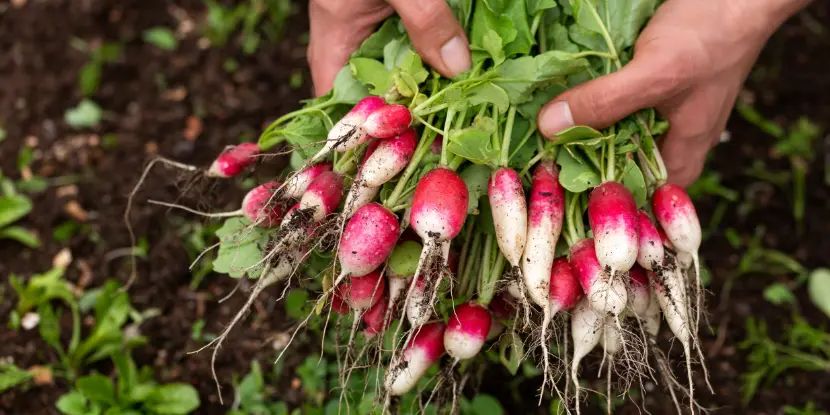
French Breakfast radishes with their distinctive coloring and shape.
Preparing the Soil
Follow these steps to prepare your garden bed:
- Soil Type: Radishes prefer loose, well-draining soil. A sandy loam allows roots to expand and retains moisture without becoming soggy.
- Adjust the pH: Aim for a pH between 6.0 and 7.0. Add lime to increase it or sulfur to decrease it.
- Enrich the Soil: A few weeks before planting, incorporate organic matter like compost or well-rotted manure into the soil.
- Ensure Proper Drainage: Excess water can lead to root rot. Consider raising your beds or incorporating more organic matter to improve soil structure and water flow.
- Break Up Compacted Soil: Use a garden fork to gently turn and loosen the soil to a depth of at least 8-10 inches. Compacted soil will hinder root growth.
Planting Radishes
Timing
Radishes are a cool-season crop. In Southern California’s Mediterranean climate, early spring and late summer are the best times to plant.
For a continuous harvest, you can plant radishes every two weeks, starting as early as February and continuing through April. A late summer planting can begin in late August and continue through September for a fall harvest.
Radishes mature quickly. Usually, you can can harvest them within a month of planting.
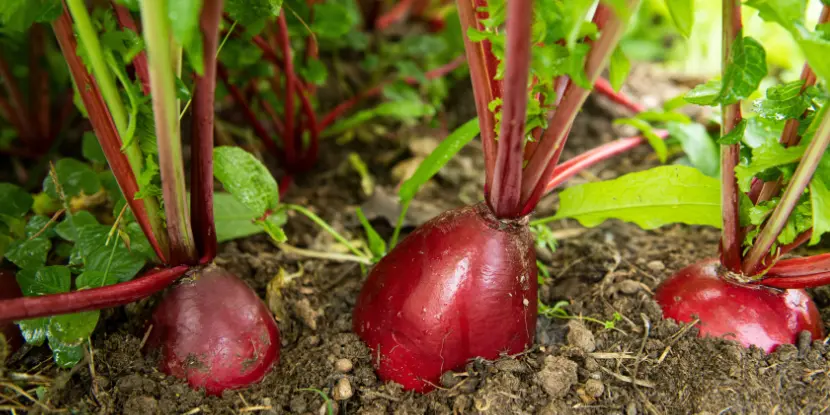
Japanese radishes ready to be harvested.
Planting Process
- Select a Sunny Spot: Radishes need about six to eight hours of direct sunlight daily.
- Prepare the Bed: Use the prepared soil from your garden bed, ensuring it’s loose and well-draining. Remove any stones or debris that could obstruct growth.
- Sow Seeds Directly: Radishes don’t transplant well. Plant radish seeds directly in the garden, sowing seeds 1/2 inch deep and 1 inch apart in rows spaced 6 inches apart.
- Water Gently: Water the soil thoroughly to settle the seeds. Keep the soil evenly moist but not soggy.
- Thin Seedlings: When the radish plants are an inch high, thin the seedlings so they stand 2 inches apart. This gives each radish enough room to grow to its full size.
Watering & Care
Watering
- Keep the Soil Evenly Moist: Radishes need consistent moisture to flourish.
- Avoid Over-Watering: Too much water can dilute the taste of the radishes and cause root rot. Allow the soil to dry slightly between waterings.
- Use a Drip Irrigation System or Water Gently at the Soil Level: Drip irrigation reduces water waste and prevents the foliage from getting too wet, which can lead to leaf diseases.
Fertilizing
- Use a Low-Nitrogen, High-Potassium Fertilizer: Apply a balanced fertilizer with more potassium than nitrogen (for example, 5-10-10 (N-P-K). Potassium promotes healthy root development, while too much nitrogen encourages foliage growth at the expense of the roots.
- Apply Fertilizer Sparingly: Over-fertilizing can harm your radishes. Apply a side dressing of fertilizer about two weeks after planting, using only half the recommended rate on the package.
- Incorporate Compost: Adding compost to the soil before planting provides a slow release of nutrients beneficial for root crops like radishes.
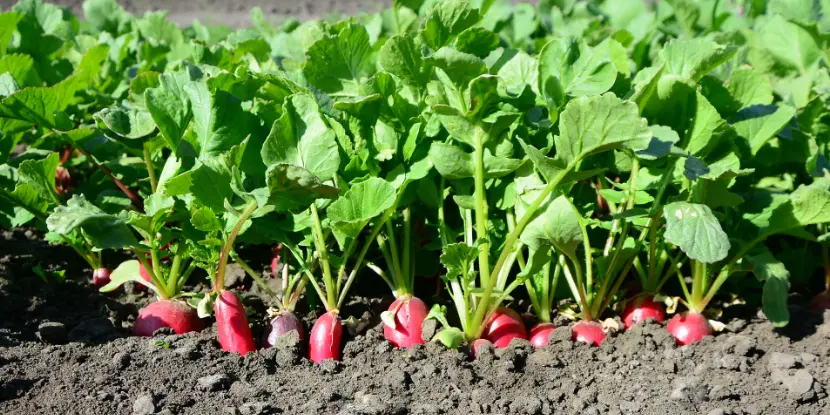
Radishes in the field as they approach maturity.
Pest & Disease Control
Radishes are susceptible to several pests and diseases. Here’s how to manage them organically:
Pests
- Flea Beetles: These tiny bugs chew small holes in the leaves. To protect your crops, use floating row covers and apply diatomaceous earth around the base of the plants.
- Root Maggots: Root maggot larvae can damage the roots. Practice crop rotation to prevent infestation and apply beneficial nematodes to the soil to target the larvae.
- Aphids: Knock aphids off leaves with a jet of water and introduce natural predators like ladybugs to discourage their return.
Diseases
- Clubroot: This fungus causes swollen and deformed roots. To prevent it, maintain the soil pH around 7.0 and practice crop rotation.
- Downy Mildew: This appears as yellow patches on the leaf surface and a fuzzy growth underneath. Ensure good air circulation around your plants and water in the mornings so foliage can dry before evening.
- White Rust: White rust manifests as white pustules on the undersides of leaves. Remove and destroy infected plants and avoid overhead watering.
When to Harvest Radishes
- Check Size: Radishes are ready to harvest when they’re about the size of a large marble or slightly larger, depending on the variety. Gently brush away some soil at the top of the radish to check its size.
- Timing: Most radishes mature between 22 and 30 days after planting. Early varieties can be ready in as little as three weeks, while larger varieties like Daikon may take longer.
- Leaf Growth: Look for large and lush radish leaves to indicate the radishes are ready.
- Firmness: Gently squeeze the top of the radish. It should feel firm and solid. Soft or squishy radishes may be overripe.
- Harvest Early: Radishes taste best when harvested young. If left in the ground too long, they can become woody and too peppery.
- Pull Gently: Grasp the radish at the base of the stems and pull gently. If the soil is hard, loosen it with a garden fork before pulling.
- Harvest in Cool Part of the Day: Harvest radishes in the morning or late afternoon when temperatures are cooler. This helps maintain their crisp texture and sharp flavor.
FAQs: Radish Plant Care
Q: How can I prevent my radishes from becoming too spicy?
Radishes develop a more potent, spicy flavor under stress, particularly due to lack of water and high temperatures. To ensure a milder taste, keep the soil consistently moist without overwatering, and plant radishes in the cooler parts of the season (early spring or late summer). Harvest them as soon as they reach maturity to prevent them from becoming overly spicy.
Q: Can radishes be grown in containers?
Radishes can thrive in containers as long as they have enough depth for root development and proper drainage. Choose a container at least six inches deep and fill it with a loose, well-draining soil mix. Ensure the container receives ample sunlight and keep the soil moist.
Q: Do radishes need full sun to grow?
Radishes perform best with at least six to eight hours of direct sunlight daily. They can tolerate partial shade, especially in warmer climates, but this may slow their growth and prolong the time to harvest.
Q: How do I know if my soil drains well?
Dig a hole about a foot deep and fill it with water. If the water drains within an hour, your soil has good drainage. If it takes longer, you may need to amend it with organic matter like compost or build a raised garden bed.
Q: Can I plant radishes next to other vegetables?
Radishes are excellent companions for lettuce, cucumbers, and carrots. Avoid planting them next to hyssop, which can inhibit their growth.
Q: How often should I water my radish plants?
Water radish plants deeply and keep the soil evenly moist. During dry spells or in hot weather, this could mean watering every day or every other day, depending on your soil type and climate.
Q: What’s the best fertilizer for radishes?
A low-nitrogen, high-potassium (e.g., 5-10-10) fertilizer promotes healthy root development without excessive foliage. Apply it sparingly according to the directions.
Q: How can I combat radish pests naturally?
Practice crop rotation, use floating row covers to protect the plants, and introduce natural predators like ladybugs for aphids. Diatomaceous earth can deter flea beetles, and beneficial nematodes can manage root maggots.
Q: My radishes are tiny. Why?
Overcrowding, insufficient sunlight, or overly compacted soil may be to blame. Thin your radish plants, ensure they get enough light, and keep the soil loose and fertile.
Q: Why are my radish leaves healthy, but the roots are small or nonexistent?
This often happens when there’s too much nitrogen in the soil or insufficient space between plants. Apply a fertilizer with higher phosphorus and potassium, and thin the plants to allow space for root development.
Q: How long can I store harvested radishes?
Radishes can last up to two weeks if stored in the refrigerator unwashed and with the tops removed. To help retain freshness, store them in a perforated plastic bag and place them in the crisper drawer.

